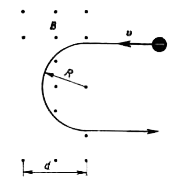Prove that a charged particle entering a strong uniform magnetic field experiences specular reflection, if its speed is below some limiting value (the "magnetic mirror" principle, Fig. 28.20). Find the kinetic energy of the electrons which experience specular reflection, if the electron beam is perpendicular to the magnetic mirror" magnetic field with an induction B= 0.1 T is established in a large region, the thickness of the magnetic mirror" is d= 10 cm. 
Text Solution
The correct Answer is:Less than 2.5 MeV
A charged particle entering a magnetic field perpendicularly to the lines ur induction will move along tho are of a circle of radius R=p/eB, where μ is the momentum of the particle, Mirror rellection takes place if the entire path of the particle happens to lie inside the field.
Since, according to the conditions of the problem, the electrons move perpendicularly to the "magnetic mirror" they will be reflected backwards, provided that the radius of the semicircle is less than the thickness of the "mirror" Hence peB<d.
The total energy of the electron is ε=√ε2Ψ+l2c2<√e2v+e2B2a2c2) the kinetic energy is K =ε−ε0. Finally, we get K<ε0(√1+(eBd/mec)2−1)
|
Updated on:21/07/2023
Similar Questions
Knowledge Check
- Question 1 - Select One
When a charged particle enters a uniform magnetic field its kinetic energy
Aremains constantBincreasedCdecreasesDbecomes - Question 2 - Select One
When a charged particle enters a uniform magnetic field its kinetic energy
ARemains constantBIncreasesCDecreasesDBecomes zero - Question 3 - Select One
A charged particle enters a uniform magnetic field perpendicular to it. The magnetic field
Aincreases the K.E. of the particleBdecreases the K.E. of the particleCchanges the direction of motion of the particleDdoes both (a) and ( c)
If a charged particle enters perpendicular in the uniform magnetic field then
View SolutionA charged particle enters into a uniform magnetic field and experiences upward force as indicated in figure. What is the charge sign on the particle?
 View Solution
View SolutionIf a charged particle enters perpendicular in the uniform magnetic field then
View SolutionPath of an electron entering perpendicular in a uniform magnetic field will be:
View SolutionA charged particle enters in a uniform magnetic field with a certain velocity. The power delivered to the particle by the magnetic field depends on
View Solution

